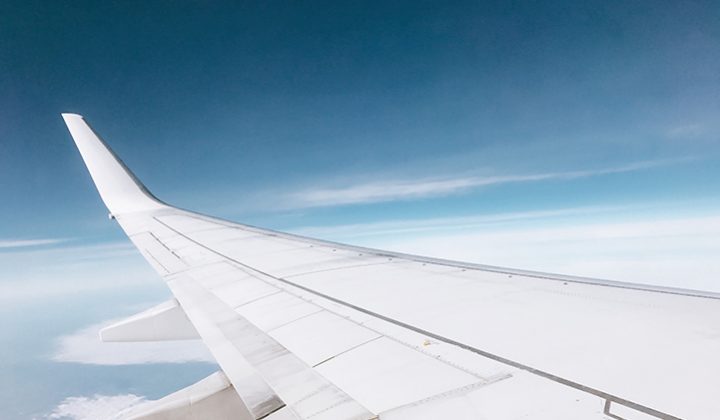A core sector of the French industry, aeronautics must innovate to carry an increasing number of passengers in performing and environment-friendly aircrafts, in a highly competitive global market. ESILV trains students to become engineers in the aeronautics and space industry, through the Computational Mechanics and Modelling major.
Here are three final-year projects led in teams by 5th-year engineering students, as part of the engineering school learning by doing educational approach.
Study of the aircraft control system of an A320
A project led by Tanguy BRUCHEC, Hélène CLECH and Mohamed ELOFIR.
This engineering project is part of the Altair Aircraft Safety Challenge. With this challenge, the provider of engineering software has engineering students think about safety related problems in aircrafts, using simulation and digital modelling tools.
This project consisted in studying the aircraft control system of an A320 and its potential loss under specific conditions. The loss of commands is the cause of a lot of accidents.
This loss can be caused by an engine stop or by the resonating state of the aircraft’s wings. The engineering students did their study on an A320 aircraft, with two engines. They considered the aircraft was in the cruise phase of the flight and one engine broke.
This industrial innovation project is made of two parts: firstly, the feedback control and the aircraft control system and secondly, the resonating state of the aircraft’s wings. In order to complete their study, engineering students used the Activate software and HyperWorks, all developed by ALTAIR.
Aircraft control system an feedback control
The feedback control was done in height, the aim being to find the PID corrector’s parameters (K, KI and KD) to ensure the best stability, precision and speed of the system. Each parameter of the corrector acts differently on the system behaviour, a compromise must be found to have the best PID corrector.
Then, the engineering students introduced disruptions to simulate a critic effect on the aircraft, for instance an engine stop. By the same action, they had to find the right corrections to restore the aircraft control system after the emergence of disruptions. Students have also studied the feedback control in position with the same actions of PID corrector, with and without disruptions.
Wings’ resonating state
For the wings’ resonating state study, students have achieved a theoretical study and several modal analysis. An aircraft suffers some constraints, which deform the longitudinal sails (wing spar bending) and transversally (twist of wing ribs), when in flight. When the air speed increases around a wing, the frequency of twist movements decreases and the frequency of bending movements increases. There is a speed, called critical speed, when these two frequencies are in phase and can move into a resonating state.
This phenomenon is divergent, it amplifies the bending and twist movements and results in an aeroelastic-coupling that can destroy the wing. The modal analysis enabled students to find the eigenmodes and eigenvalues, and viewing the deformations under some specific frequencies.
Fluid and plane modelling in the case of an emergency sea landing
An industrial engineering project by Dimitri FALCK, Vivien FERNANDES, Sébastien PEREZ and Antoine PORT.
This project also competed in the Altair Aircraft Safety Challenge and is centered on the emergency sea landing of an Airbus A320.
Students used numerical analysis and computer science to simulate the emergency sea landing of an A320 aircraft. The main objective was to establish a model of crash and the effects of the water impact on the fuselage. Therefore, students needed to understand and handle most of the features of the HyperMesh software to get the accurate results.
Fluid and plane modelling were at the heart of the project, students seized the opportunity to use work from former Altair Aircraft Safety Challenge contestants on this subject.
Students used the “SPH” method. The SPH method, for Smooth Particle Hydrodynamics, is a new definition of the fluid in the form of particles. In other words, each point forming water is independent and its displacement or impact on the plane’s structure can be tracked with great precision.
This method is time demanding but students used it anyhow to prove the feasibility and the limits of this method. Students agreed to say there is no small project in aeronautics, all the more when safety is at stake. Each progress might allow civil aviation to become safer.
ASTREOS, the first bi-liquid rocket – CNES MINERVA Macro-project
A project developed by Adrien AROULANDA, Louis JOSEPH , Yassine MEMOUNE and Emeric VIAR.
The PERSEUS project is an initiative of CNES, the French National Center for Space Studies.
The PERSEUS project aims to support the emergence of the innovative technical solutions for space projects carried out by higher education students. This group of ESILV students joined the PERSEUS programme in September 2017 to develop two new tanks for the first ASTREOS bi-liquid rocket.
This project is part of the MINERVA macro-project, launched in September 2010. This macro-project aims at developing a new method of bi-liquid propulsion whose yields will be much higher than current propellers. This engineering project is based on the studies of the students’ previous year project.
Students had to take into account an update by CNES which led to a modification of one of the propellants and dimensions of the tanks. This year’s project’s main goals were the validation of the material of ours tanks, the finalization of thermal and mechanical studies, the development of a test methodology and the study of tanks manufacturing processes.
The PERSEUS seminar allowed students to present their progress on this project and to obtain valuable information to prepare the manufacturing of their tanks.
More information about ESILV’s programme and its project-based educational approach.
This post was last modified on 3 May 2018 12:43 pm









